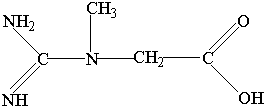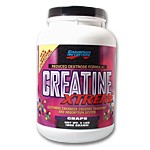How Much Creatine in Ground Beef
Creatine

chemical structure of creatine
What is Creatine?
Creatine is an amino acid, with the chemic name methyl guanidine-acetic acid, that tin can exist converted into the phosphocreatine. Phosphocreatine is storage machinery muscle cells use to regenerate the cells primary source of energy adenosine triphosphate (ATP). Phosphocreatine has the ability to react with adenosine diphosphate (ADP), a byproduct of muscle wrinkle, and catechumen ADP to ATP for firsthand energy.

Were does it come from?
Creatine tin be synthesized in the liver, kidney, and pancreas from the three common amino acids Arginine, Glycine and Methionine. This involves a reversible transfer of an amidine group from arginine to glycine to form guanidinoacetic acid. An irreversible transfer of a methyl grouping then follows up this footstep from S-adenosylmethionine to the guanidinoacetic acid to grade creatine. When creatine is obtained in the diet this mechanism is suppressed. Creatine tin can as well be located in the diet from milk, steak and some fish. Beefiness, pork, tuna, salmon, and cod all contain betwixt 1.iv to 2.three grams of creatine per pound. Herring contains the nearly creatine at 3 to iv.5 grams per pound. Recently creatine supplementation has become an issue equally a performance enhancing product.
How tin Creatine be taken?
There are many products available for the supplementation of creatine into the body. Liquids, powders, tablets, gel caps, effervescent tablets, and even chewing gums are being used as a delivery mechanism of creatine. Creatine has been known about for 160 years, and was first used every bit a supplement in World State of war I past High german scientist. It was given to German soldiers to reduce fatigue in combat.
What happens when Creatine is ingested?
When the body uptakes creatine into the body in that location are 4 documented effects. The first effect is the most important benefit of the product which is the quick transformation of ADP to ATP from creatine phosphate. This is important because in the human body there is an expendable corporeality of ATP, which will be consumed in ten to fifteen seconds of maximal exertion. Creatine can also aid volumize musculus cells. Creatine helps pull water into muscle cells increasing their size. It is unclear if this effect has any benefits to heighten forcefulness but the start effect is by far the well-nigh important. Recent studies likewise take shown of 2 more than possible effects. Creatine has been show to buffer Lactic Acid build-up and raise protein synthesis. These effects have not been tested enough and more research must be completed to determine their validity.
How much Creatine?
The amount of creatine per person varies depending on the persons weight and muscle mass. An boilerplate male weighing 160 pounds would have about 120 grams of creatine in their system. 95%-98% of this creatine would be stored in muscles and the other 2%-5% would be institute in the brain, heart and testes. About ii grams of creatinine, the waste product of creatine, would be excreted per day and half of this amount would be from liver synthesis. The other half would be from that persons nutrition. Many producers of the creatine supplement insist on loading with creatine for the get-go week. This loading dose could be as much as xx grams per day. It has been shown that there are non great gains in strength, musculus mass, or indurance for those who load compared to those who don't load. The loading phase probably is just a scheme for the producers of the product to make more coin. The recommended dose of creatine supplement is 5 grams per day. Creatine should be taken in cycles, meaning that it should be supplemented for a period of time and and so that person should accept a pause from the supplementation.
Should Creatine be banned from athletic performances?
Creatine should not and could non be banned course athletic competitions. An athlete who consumes creatine tin only hold about five grams of creatine per kilogram of muscle and this amount could be obtained through eating large quantities of meat and fish. The same waste product product of creatine, creatinine, would be excreted in the urine and the competitor could non exist excluded from competition. Creatine, one of the most widely known and used products has no immediate detrimental side effects. It has been one of the most widely analyzed and researched natural supplement and no evidence has been found that supplementation of this product, along with a well balance nutrition, is harmful. When one supplements with creatine it is necessary to potable plenty of h2o making certain not to put strain on the kidneys.
Related links
http://www.sportsci.org/traintech/creatine/rbk.html
Back to Chief Folio
Source: https://www1.udel.edu/chem/C465/senior/fall00/Performance2/creatine
0 Response to "How Much Creatine in Ground Beef"
Post a Comment